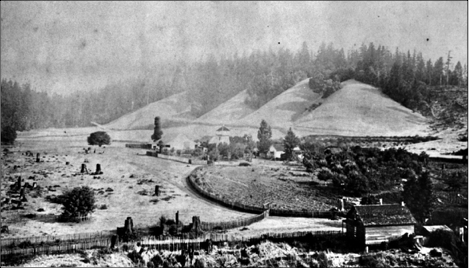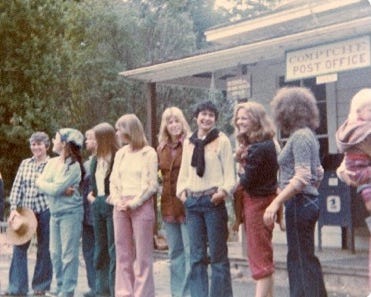“Truly a Garden of Eden,” is how local historian Elsa Thompson described the small town and environs in her book, Early Settlers of Comptche Along its Many Roads. She published her book in 1973, during the peak of Back-to-the-Land immigration.
“We fell in love with the redwoods.” Newcomer participant, 2011
“There’s a shared respect and love about Comptche’s specialness. We each will likely define this differently but we all share the feeling.” Old-timer participant, 2011.
“We liked the secluded wilderness and pristine beauty of the forest. It provided an opportunity for us to live off the land, simplify our lives and strive for self-sufficiency.” Newcomer participant, 2011.
Such romantic descriptions reflect the common passion for the place. The beauty of the Redwood Coast has been consistently noted by historians, timber barons, explorers, and settlers.
During his fieldwork to learn about the Pomo people, anthropologist Alfred Kroeber wrote in 1925 about being awestruck by the Redwood Coast to the point of distraction.
Land is the common reason why immigrants have chosen to live in Comptche since the first homesteader in 1867. Among the many voices comprising my research in various forms—oral histories, academic and popular literature, respondents’ statements—resoundingly these voices say the Redwood Coast is a place of stunning natural beauty. So, beauty of place is the common reason for living here. Place then, becomes a way to understand the culture.
During the first forty to fifty years that settlers lived in Comptche, the Pomo and the immigrants shared the land. It was truly common ground. In their oral histories, the first homesteaders reveal tolerance, even friendship, with the Buldam Pomo who continued to camp, harvest, and travel the Comptche commons.
The area was among the Pomos’ usual and accustomed places. The Pomo originally had primary use rights, the commonly understood relationship to land held by Native Americans. The Pomo continued their primary use rights during an era of peaceful co-existence with settlers in Comptche.
Concurrently, these lands were being divided up by the federal government as “parcels” according to the Western concept of land ownership. These parcels were then purchased from the U.S. by homesteaders.
Oral histories relate that early settlers of Comptche and the Pomo interacted and shared information. They had a relationship. Commentary written in the late 1800s and early 1900s about the region’s native people can be degrading and piteous, but accounts of fear are limited to mountain lions and bears. The settlers did not fear the Pomo, the natives and the newcomers managed a relatively peaceful coexistence. (For more on the Buldam Pomo of Comptche, see post 3.2)

Comptche Today
Comptche is an unincorporated town spread out over a ten-mile radius. This area is officially designated as the Comptche Community Services District (CCSD), and it is through the services district that the fire department receives funds from Mendocino County.
The center of town is situated at the hub of this ten-mile radius and it is there that some of the town’s most important gathering places are located: a U. S. Post Office, the Comptche Store, the Chapel of the Redwoods, and the Comptche School for children in kindergarten through third grade. At the time of my fieldwork, the U.S. Census of 2010 reports a population of 483. In 1970, the population was 463.
Up next: 4.2 Differences in the Other
Resources for this post:
Docker, Ethel, 1968. The Good Old Days.
Hoak, Charlotte, 1954. How Comptche Got Its Name, in The Mendocino Beacon, 11/6/54.
Kelley House Museum, 2011. Native Inhabitants, electronic document.
Tahja, Katy, 1999. Logging Railroads of Humboldt and Mendocino Counties.
Thompson, Elsa, 1973. Early Settlers of Comptche Along its Many Roads.







